The Battle of York was a War of 1812 battle fought in York, Upper Canada on April 27, 1813. An American force, supported by a naval flotilla, landed on the western lakeshore and captured the provincial capital after defeating an outnumbered force of regulars, militia and Ojibwe natives under the command of Major General Roger Hale Sheaffe, the Lieutenant Governor of Upper Canada.
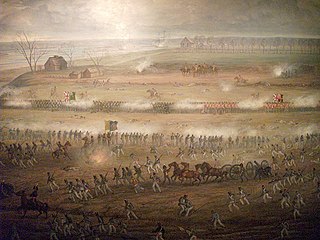
The Battle of Crysler's Farm, also known as the Battle of Crysler's Field, was fought on 11 November 1813, during the War of 1812. A British and Canadian force won a victory over a US force which greatly outnumbered them. The US defeat prompted them to abandon the St. Lawrence Campaign, their major strategic effort in the autumn of 1813.
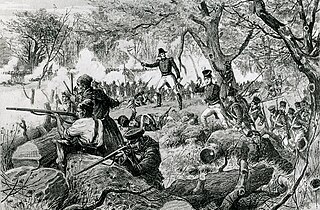
The Battle of the Chateauguay was an engagement of the War of 1812. On 26 October 1813, a combined British and Canadian force consisting of 1,530 regulars, volunteers, militia and Mohawk warriors from Lower Canada, commanded by Charles de Salaberry, repelled an American force of about 2,600 regulars which was attempting to invade Lower Canada and ultimately attack Montreal.

The Battle of the Windmill was a battle fought in November 1838 in the aftermath of the Upper Canada Rebellion. Loyalist forces of the Upper Canadian government and American troops, aided by the Royal Navy and U.S. Navy, defeated an invasion attempt by a Hunter Patriot para-military unit based in the United States, which had the intention of using the beachhead as a launchpad for further offensives into Canada. Canadian, British, and American troops thwarted the invasion, successfully defending Canadian soil and forced the invaders to surrender. Others still in the U.S. were captured and arrested by U.S. officials.

The Second Battle of Sacket's Harbor, or simply the Battle of Sacket's Harbor, took place on 29 May 1813, during the War of 1812. A British force was transported across Lake Ontario and attempted to capture the town, which was the principal dockyard and base for the American naval squadron on the lake. Twelve warships were built here. The British were repulsed by American regulars, militia, marines and sailors.

The Battle of Ogdensburg was a battle of the War of 1812. The British gained a victory over the Americans and captured the village of Ogdensburg, New York. Although small in scale, it removed the American threat to British supply lines for the remainder of the war.
The Raid on Gananoque was an action conducted by the United States Army on 21 September 1812 against Gananoque, Upper Canada during the War of 1812. The Americans sought to plunder ammunition and stores to resupply their own forces. Gananoque was a key point in the supply chain between Montreal and Kingston, the main base of the Provincial Marine on the Great Lakes. Under the command of Captain Benjamin Forsyth, the Americans departed Ogdensburg, New York and sailed to Gananoque, where they encountered resistance from the 2nd Regiment of Leeds Militia. The British militia was forced to retreat and the Americans successfully destroyed the storehouse and returned to the United States with captured supplies. As a result of the raid, the British strengthened their defences along the St. Lawrence River.
Benjamin Forsyth was an American officer of rifle troops in the War of 1812 between Britain and the United States. Born in North Carolina, Forsyth joined the United States Army in 1800 as an officer and was a captain of the Regiment of Riflemen at the outbreak of war in 1812. He led raids into Upper Canada along the Saint Lawrence River in 1812–13 before transferring south and taking part in the battles of York and Fort George. Promoted to brevet lieutenant colonel, he held a command along Lake Champlain. Forsyth was killed in June 1814 at Odelltown, Lower Canada.
The Raid on Elizabethtown occurred on February 7, 1813, when Major Benjamin Forsyth and 200 regulars and militia crossed the frozen St. Lawrence River to occupy Elizabethtown, Upper Canada, seize military and public stores, free American prisoners and capture British military prisoners. This was the second successful raid by Forsyth along the St. Lawrence River, having previously attacked Gananoque. The success of the two raids prompted a response by the British, which culminated in the Battle of Ogdensburg.
George Richard John Macdonell, commonly known as Red George, was an officer in the British Army who played a conspicuous part in the War of 1812.

Fort Wellington National Historic Site is a historic military fortification located on the north shore of the St. Lawrence River at Prescott, Ontario. The military fortification was used by the British Army, and the Canadian militia for most of the 19th century, and by the militia in the 20th century, until 1923, when the property was handed over to the Dominion Parks Commission, the predecessor to Parks Canada. The fort was earlier named a National Historic Site of Canada in January 1920.
John Kilborn was a militiaman, merchant, lumberman and political figure in Upper Canada, and was an early settler of Newboro, North Crosby.
The Glengarry Light Infantry Fencibles were a light infantry unit, raised chiefly in the Glengarry District of Upper Canada shortly before the outbreak of the Anglo-American War of 1812. The unit fought throughout the war, and was disbanded shortly afterwards.

The Regiment of Riflemen was a unit of the U.S. Army in the early nineteenth century. Unlike the regular US line infantry units with muskets and bright blue and white uniforms, this regiment was focused on specialist light infantry tactics, and were accordingly issued rifles and dark green and black uniforms to take better advantage of cover. This was the first U.S. rifleman formation since the end of the American Revolutionary War 25 years earlier.
Where can you find troops more efficient than Morgan's riflemen of the Revolution or Forsyth's riflemen of the last war with Great Britain?
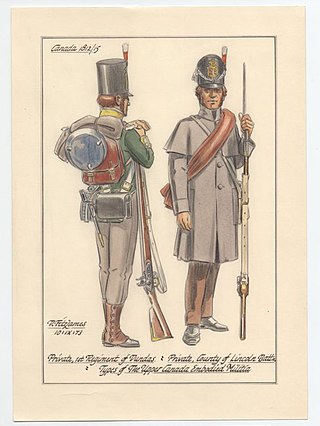
The Dundas County Militia was a regiment of the provincial militia of Upper Canada that was raised in Dundas County, Ontario, in the 1780s. The battle honours and legacy of the Dundas Militia are perpetuated by the Stormont, Dundas and Glengarry Highlanders.
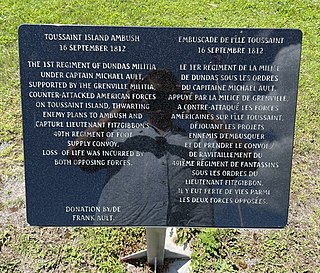
The Battle of Matilda, also known as the Battle of Toussaint's Island, was an early skirmish of the War of 1812 fought on September 16, 1812 between American and Canadian militia in the St. Lawrence River near the township of Matilda, in Dundas County.
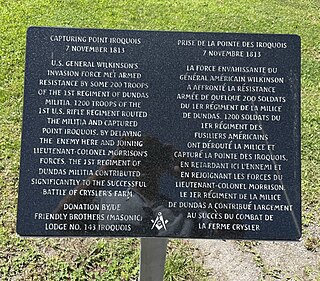
The Battle of Point Iroquois was a small skirmish fought on the morning of November 8, 1813, as part of Wilkinson's advance up the St. Lawrence towards Montreal. The skirmish occurred on the shores of the St. Lawrence River at Point Iroquois, Dundas County, where the river reached its narrowest point, only 500 yards across.
The Salmon River Raid was a raid conducted by British forces in February 1814 against the recently abandoned American bases along the Salmon River near French Mills, New York. A previous raid and battle at French Mills had been conducted in 1812.
The Raid on Madrid was a small raid by Canadian Militia and Royal Marines on the village of Madrid, New York, during the War of 1812.









